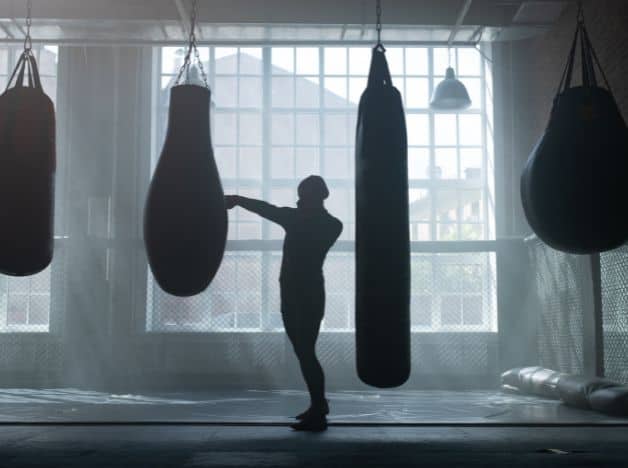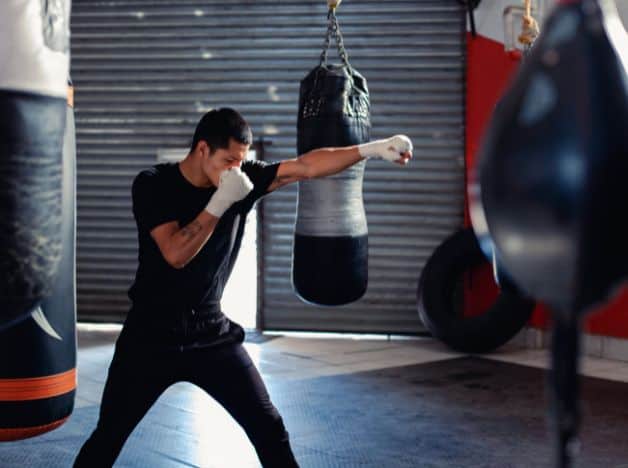When it comes to punching bags, there are many options available to choose from. The most popular being hanging heavy bags and freestanding punching bags. Between the two types, there are also different variations that are more specialized and also beneficial to use.
The key to deciding which bag is right for you is to first determine what your goals are. Are you looking to improve your strength, cardiovascular fitness, or skills? Answering this question gives you a better idea to what might be a good fit for your workout and improvement.
Aside from meeting your personal goals, you also want to look for a punching bag that meets a certain standard of quality, weight and price. Depending on what type of punching bag you want, all these will vary widely and the choices are abundant. In this article we will go through the type of workouts you may be considering, matching the type of bag and how do decide on the specific one.
When it comes to specialized bags, there are a few popular options to consider. The speed bag, for example, is great for improving hand-eye coordination, speed, and precision. This small, inflated bag is suspended by a swivel and requires quick reflexes and precise strikes to keep it moving. Angle or Uppercut bags gives the boxer more options in practicing the types of punches and giving a more dynamic workout and perfect for working on power and technique. And the standard cylindrical hanging heavy bag as well as free standing punching bags will be a good choice for the standard boxing workout.
When choosing a punching bag, consider the following factors:
- Material: Leather bags are durable and provide a realistic feel, while synthetic bags are less expensive and require less maintenance.
- Size and weight: Make sure the bag is the appropriate size and weight for your height, strength, and training goals.
- Hanging system: Look for a bag with a sturdy hanging system that can support the weight of the bag and withstand the force of your strikes.
- Brand reputation: Look for a brand that has a good reputation and warranty.
- Purpose: Consider whether you want a bag for heavy bag workout or for MMA or Kickboxing training as that will determine the weight and material of the bag you choose.
Different types of punching bags and what they’re good for.
Choosing the Right Weight, Size And Style Of A Punching Bag
There is a few factors to consider when choosing the right punching bag that would make a significant difference in your workout or boxing training. In short, highly consider your skill level, what you’re training for and your personal preference. With these in mind, it will help you make better decisions on the next few items we are going to talk about.
An important consideration when choosing a punching is its weight. Common types of heavy bags typically weigh somewhere between 80 to 100 pounds. A general rule of deciding which weight is best for you is dividing your personal weight in half and that would be the weight of the punching bag you should get. That’s a starting point anyway. Depending if you’re looking to build strength it is generally a better idea to get something heavier and alternatively, when looking to build speed and coordination. A much lighter punching bag that moves quicker would be ideal.
Along with getting the proper weight, you would need to consider size at the same time, both the length and width of the punching bag. Having a large punching bag but at a weight that is too light for you will cause the bag to be too flat and swing wildly. If you’re looking for a general boxing workout, a larger and heavier bag should work nicely. If you’re fine tuning your punches or speed, a type of bag that is smaller and moves quicker will help with coordination and reflexes.
Knowing your goals and what you would like to focus on in your workouts is especially important when it comes to choosing the style of your punching bag. There’s different options of punching bags that help fit multiple areas of a boxing workout. Some categories are wrecking balls, angled heavy bags, speed bags and so on. If you’re doing workouts from home you will likely only need 1 that would be suffice for your everyday workouts. Or at most you can get two, one for speed and one for strength.
The material or make of the punching bag is another factor to consider as well. Leather bags are likely the most durable but also comes with the highest price tag. You would also need to put more maintenance and care into it which results in added cost and time. The synthetic types are most common and a good enough durability for home users. The price tags are also more on the affordable side and if you put minimal care into it it should still last a really long time.

What Is A Good Punching Bag For Beginners
What I would recommend for beginners or for those that just want a no fuss punching bag are the standard hanging heavy bags or freestanding punching bag. Both are cylindrical in shape and offer pros and cons for your training. The hanging heavy bag is versatile and allows you to work on a variety of techniques such as straight punches, hooks, kicks, elbows, and even knees. However, it does require a significant amount of space and a secure area to hang it from. If you don’t have the space or don’t want to put a hole in the wall, you can opt for a heavy bag stand instead.
The second option, the freestanding punching bag requires no mounting and is much easier to place in your home or gym. It’s a great choice if you have limited space and plan on using the bag primarily for fitness purposes. However, the freestanding bag does have its limitations in terms of strength building and movement in the bag. It’s a good option to practice foot movement and drills, but it doesn’t provide the same level of movement as a hanging heavy bag.
Between the two choices, if you have the space and capacity to hang a punching bag from the ceiling. I would opt for a heavy hanging bag pretty much 100% of the time. Mainly because it is the best way to maximize your workouts at home. Just keep in mind that you will need a decent amount of space in order to install and use it properly. If hanging it from a ceiling is not possible you can always use a bag stand to hang it from.
If you have limited space and plan on using the bag primarily for fitness, a freestanding bag is still a good option. It’s the easiest to set up, take down and move around and will fit your needs when it comes to boxing for fitness. We have a much more in depth article on how to choose between freestanding punching bags that will help guide you to one that is best for you.
What Is A Good Weight For A Punching Bag
Like we mentioned earlier, typically the way to find a punching bag weight that is good for you is to divide your own weight in half. If you weight 200 pounds then go no lower then a 100 pound punching bag, if you weigh 140 pounds look at the range of 70+ pound punching bag. I would recommend to test out a couple in that range. You might find that you will need something heavier, or lighter that would be a better fit for you.
Ideally if you find a punching bag that gives a bit of resistant when you hit it, is still comfortable and commits a bit of a swaying motion. Then that is probably where you want to be at in terms of the right punching bag.
What Type Of Materials Should You Consider Before Buying A Punching Bag
When buying a punching bag, there are several types of materials to consider. Each material has its own unique properties that can affect the feel and durability of the bag.
One popular material for punching bags is leather. Leather bags are known for their durability and authenticity. They are often used in professional boxing gyms and provide a more realistic feel for punches and kicks. However, they can be quite expensive and require regular maintenance to keep them in good condition.
Another popular material is synthetic leather or vinyl. These bags are more affordable than leather and are often used in home gyms and dojos. They are also more resistant to wear and tear and require less maintenance. However, they may not provide the same feel as a leather bag and can be less durable over time.
Canvas punching bags are another common option. They are made of heavy-duty canvas and can withstand a lot of punishment. They are also relatively inexpensive and are a good option for beginners. They are usually filled with materials such as sand, rags, or other materials.
General Boxing Training Punching Bags
A heavy hanging bag or simply a punching bag, is the meat of any boxer’s training regimen. The benefits of using a heavy bag are numerous, making it a great option for both amateur and professional fighters looking to improve their skills and conditioning. And the one that is highly suggest to start with or own.
One of the main benefits of using a heavy bag is that it allows fighters to practice their striking techniques with resistance. The bag’s weight and resistance to movement mimics the feeling of hitting a real opponent, allowing fighters to develop power and accuracy in their punches. And training this way is not only beneficial for fights but it is a great workout on its own also.
Using a heavy bag also helps improve cardiovascular fitness. The constant movement and strikes required to hit a heavy bag can provide a challenging cardio workout, helping fighters to up their endurance and stamina. This is particularly important for boxers, who often have to fight for several rounds in a match, and need to be able to maintain their energy levels throughout the fight.
When asked what type of punching bag you should get. I typically will give the answer of using an angled bag. It can perform just as well as a standard cylindrical punching bag but with the increased top and tapered bottom, you get more options on what you can train for.
Speed And Coordination Punching Bags
Speed bags, double-ended bags and reflex bags are all great choices for improving speed and coordination in boxing.
Speed bags are small, round bags that are suspended from a platform and are typically used to improve the speed and precision of a boxer’s punches. The fast, back-and-forth movement of the speed bag requires quick reflexes and hand-eye coordination, making it a great for developing precision and timing. The repetitive motion of hitting the bag also helps to improve the speed of a boxer’s punches, making them more effective in the ring.
Double-ended bags, also known as floor-to-ceiling bags, are similar to speed bags in that they are used to improve punch speed and coordination. These bags are fastened from the floor and ceiling that helps give it the rapid movements. Double end bags take it a step further because along with speed and coordination you can also use the movement of the bag for head movements and dodges.
Reflex bags are designed to improve a boxer’s reaction time and hand-eye coordination. Just like a freestanding punching bag they are suspended on a spring and attached to a base unit. Similar to the double end bag, the back and forth movement when being hit gives the boxer the option of practicing defence as well.
Strength Building Punching Bags
A hanging heavy bag and a wrecking ball are both great tools for building strength in your punches. Make sure they’re both heavier and firm so they can take the power punches that you will be doing.
Hanging heavy bags are versatile punching bags. If choosing a standard punching bag, this is where you want to make sure that it is heavy enough to continually give enough resistance needed. If you’re following the “half your weight” rule of choosing a punching bag. This may be the time to consider a slightly heavier one to give a more challenging workout.
A wrecking ball, is a large punching bag with a rounder shape. Hitting a wrecking ball requires a lot of force and power, as well as good timing and coordination. This tool is great for building upper body strength, especially in the shoulders, arms, and back and if placed high enough you can also use it for footwork and practicing boxing movements.
In addition to building physical strength, these tools also help to improve a boxer’s mental toughness. Hitting a heavy bag or a wrecking ball requires a significant amount of focus and determination, and fighters need to have the mental fortitude to push through the fatigue and keep going. This can help fighters to develop the resilience they need to stay focused and perform at their best in the ring.

Conclusion
When choosing a punching bag it may seem like there is so much to know and options to choose from. For some it may even get overwhelming but it doesn’t have to be that way. When you start from the beginning and consider your budget, the amount of space you have, and the types of workouts you are planning to do. It will help narrow your list down tremendously and bring your much closer in finding the right punching bag. If you would like to learn more about the different types of punching bags out there, we have an in depth article you can check out.
